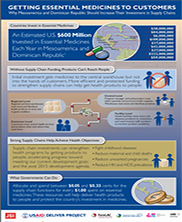The governments of Mesoamerica and the Dominican Republic have shown a strong commitment to improving the availability of essential medicines, including contraceptives, in their public health supply chains.
Strong national leadership, commitment, and coordination—coupled with partnerships among civil society, nongovernmental organizations, and the private sector—have been pivotal. Underpinning this success has been the strength and robustness of increasingly integrated and sophisticated public health supply chains. Sustaining this success comes with challenges, such as the dwindling support of traditional donors to fund both commodities and supply chain improvements. As donor funding decreases, governments need to budget adequate resources to fund public health supply chains and ensure their populations have access to essential medicines, including contraceptives. A key question remains, however: how much should they budget to fund the supply chains needed to ensure product delivery?
To answer this question, countries should estimate their supply chain costs. This requires an analysis of supply chain activities across administrative levels or tiers in the systems and different supply chain actors. In the absence of this detailed analysis, we adapted and updated an economic model first developed by JSI's USAID | DELIVER PROJECT for the World Health Organization (WHO) in 2009.
That model provided a macroeconomic estimate of the supply chain costs associated with helping 49 developing countries achieve their Millennium Development Goals (MDGs) in health (Sarley et al. 2009). The model was intended to give an idea of the total costs for supply chain to deliver essential medicines. The estimates derived from the model give a macroeconomic view of supply chain costs for initial budgeting purposes. More detailed analysis would be required in each country to validate these costs.
The updated model predicts that in Mesoamerica and the Dominican Republic, public health supply chain costs are between 33 percent of commodity values in countries with the lowest logistics performance and 13 percent in the best performing. We summarize our approach in this brief, the model used, and results generated. JSI/DELIVER PROJECT, 2016.


